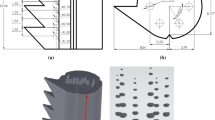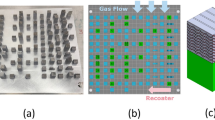Abstract
Pore is one kind of the typical defects in aluminum alloys laser welding. Porosity is an important indicator for evaluating welding quality, and porosity assessment has attracted increasing attention. This paper presents a multi-fidelity deep learning framework (MFDLF) that enables online porosity prediction without post-weld destructive inspection or radioactive detection. In the proposed approach, the maximum temperature on the bottom wall of the keyhole acquired by numerical simulation is used as the data of fidelity 1 (F1), and the coherent optical measurement technology is used to acquire the keyhole depth as the data of fidelity 2 (F2). After extracting the respective four fluctuation characteristics of the multi-fidelity data separately, a sparse auto-encoder (SAE) is used to fuse the four characteristics into an overall feature. Based on the obvious correspondence between porosity and multi-fidelity fusion features, the MFDLF is constructed with tandem two deep belief network (DBN) models, where the former DBN utilizes process parameters to predict the overall feature of F1 data (Feature 1) that is difficult to obtain in real time. Feature 1 is combined with the overall feature of F2 data (Feature 2) that can be obtained online to predict porosity through the latter DBN. The results show that the MFDLF can predict porosity with significantly higher accuracy than the models constructed using only single-fidelity data.

















Similar content being viewed by others
Abbreviations
- F1:
-
Fidelity 1
- F2:
-
Fidelity 2
- Al:
-
Aluminum
- RF:
-
Random forest
- KD:
-
Keyhole depth
- BP:
-
Back-propagation
- GB:
-
Gradient boosting
- AB:
-
Adaptive boosting
- AI:
-
Artificial intelligence
- SAE:
-
Sparse auto-encoder
- DBN:
-
Deep belief network
- MLP:
-
Multi-layer perceptron
- SVM:
-
Support vector machine
- PCA:
-
Principal component analysis
- RMAE:
-
Relative max absolute error
- RBM:
-
Restricted Boltzmann machine
- Feature 1:
-
The overall feature of F1 data
- Feature 2:
-
The overall feature of F2 data
- F-DBN:
-
The former DBN in the MFDLF
- L-DBN:
-
The latter DBN in the MFDLF
- RRMSE:
-
Relative root mean square error
- PC-MT:
-
The principal component of F1 data
- PC-KD:
-
The principal component of F2 data
- RBFNN:
-
Radial basis function neural network
- LSSVM:
-
Least squares support vector machine
- ANFIS:
-
Adaptive neuro fuzzy inference system
- MFDLF:
-
Multi-fidelity deep learning framework
- MT:
-
Maximum temperature on the bottom wall of the keyhole
References
Cai, W., Jiang, P., Shu, L. S., Geng, S. N., & Zhou, Q. (2021). Real-time monitoring of laser keyhole welding penetration state based on deep belief network. Journal of Manufacturing Processes, 72, 203–214. https://doi.org/10.1016/j.jmapro.2021.10.027
Cai, W., Wang, J. Z., Jiang, P., Cao, L. C., Mi, G. Y., & Zhou, Q. (2020). Application of sensing techniques and artificial intelligence-based methods to laser welding real-time monitoring: A critical review of recent literature. Journal of Manufacturing Systems, 57, 1–18. https://doi.org/10.1016/j.jmsy.2020.07.021
Colombo, D., Colosimo, B. M., & Previtali, B. (2013). Comparison of methods for data analysis in the remote monitoring of remote laser welding. Optics and Lasers in Engineering, 51(1), 34–46. https://doi.org/10.1016/j.optlaseng.2012.07.022
Diot, G., Koudri-David, A., Walaszek, H., Guégan, S., & Flifla, J. (2013). Non-destructive testing of porosity in laser welded aluminium alloy plates: Laser ultrasound and frequency-bandwidth analysis. Journal of Nondestructive Evaluation, 32(4), 354–361. https://doi.org/10.1007/s10921-013-0189-5
Gaja, H., & Liou, F. (2017). Defects monitoring of laser metal deposition using acoustic emission sensor. The International Journal of Advanced Manufacturing Technology, 90(1), 561–574. https://doi.org/10.1007/s00170-016-9366-x
Gaja, H., & Liou, F. (2018). Defect classification of laser metal deposition using logistic regression and artificial neural networks for pattern recognition. The International Journal of Advanced Manufacturing Technology, 94(1), 315–326. https://doi.org/10.1007/s00170-017-0878-9
Gan, Z., Kafka, O. L., Parab, N., Zhao, C., Fang, L., Heinonen, O., Sun, T., & Liu, W. K. (2021). Universal scaling laws of keyhole stability and porosity in 3D printing of metals. Nature Communications, 12(1), 1–8. https://doi.org/10.1038/s41467-021-22704-0
Gonzalez-Val, C., Pallas, A., Panadeiro, V., & Rodriguez, A. (2020). A convolutional approach to quality monitoring for laser manufacturing. Journal of Intelligent Manufacturing, 31(3), 789–795. https://doi.org/10.1007/s10845-019-01495-8
Günther, J., Pilarski, P. M., Helfrich, G., Shen, H., & Diepold, K. (2014). First steps towards an intelligent laser welding architecture using deep neural networks and reinforcement learning. Procedia Technology, 15, 474–483. https://doi.org/10.1016/j.protcy.2014.09.007
Guo, Y., Lu, W. F., & Fuh, J. Y. H. (2021). Semi-supervised deep learning based framework for assessing manufacturability of cellular structures in direct metal laser sintering process. Journal of Intelligent Manufacturing, 32(2), 347–359. https://doi.org/10.1007/s10845-020-01575-0
Harooni, M., Carlson, B., & Kovacevic, R. (2014). Detection of defects in laser welding of AZ31B magnesium alloy in zero-gap lap joint configuration by a real-time spectroscopic analysis. Optics and Lasers in Engineering, 56, 54–66. https://doi.org/10.1016/j.optlaseng.2013.11.015
Hebbal, A., Brevault, L., Balesdent, M., Talbi, E. G., & Melab, N. (2021). Multi-fidelity modeling with different input domain definitions using deep Gaussian processes. Structural and Multidisciplinary Optimization, 63(5), 2267–2288. https://doi.org/10.1007/s00158-020-02802-1
Hinton, G. E., Osindero, S., & Teh, Y. W. (2006). A fast learning algorithm for deep belief nets. Neural Computation, 18(7), 1527–1554. https://doi.org/10.1162/neco.2006.18.7.1527
Huang, L., Hua, X., Wu, D., & Li, F. (2018). Numerical study of keyhole instability and porosity formation mechanism in laser welding of aluminum alloy and steel. Journal of Materials Processing Technology, 252, 421–431. https://doi.org/10.1016/j.jmatprotec.2017.10.011
Huang, Y., Wu, D., Lv, N., Chen, H., & Chen, S. (2017). Investigation of porosity in pulsed GTAW of aluminum alloys based on spectral and X-ray image analyses. Journal of Materials Processing Technology, 243, 365–373. https://doi.org/10.1016/j.jmatprotec.2016.12.026
Huang, Y., Yuan, Y., Yang, L., Zhang, Z., & Hou, S. (2020). A study on porosity in gas tungsten arc welded aluminum alloys using spectral analysis. Journal of Manufacturing Processes, 57, 334–343. https://doi.org/10.1016/j.jmapro.2020.06.033
Ke, W., Bu, X., Oliveira, J. P., Xu, W. G., Wang, Z., & Zeng, Z. (2021). Modeling and numerical study of keyhole-induced porosity formation in laser beam oscillating welding of 5A06 aluminum alloy. Optics and Laser Technology, 133, 106540. https://doi.org/10.1016/j.optlastec.2020.106540
Lin, R., Wang, H. P., Lu, F., Solomon, J., & Carlson, B. E. (2017). Numerical study of keyhole dynamics and keyhole-induced porosity formation in remote laser welding of Al alloys. International Journal of Heat and Mass Transfer, 108, 244–256. https://doi.org/10.1016/j.ijheatmasstransfer.2016.12.019
Liu, G., Gao, X., You, D., & Zhang, N. (2016). Prediction of high power laser welding status based on PCA and SVM classification of multiple sensors. Journal of Intelligent Manufacturing, 30(2), 821–832. https://doi.org/10.1007/s10845-016-1286-y
Luo, M., & Shin, Y. C. (2015). Estimation of keyhole geometry and prediction of welding defects during laser welding based on a vision system and a radial basis function neural network. The International Journal of Advanced Manufacturing Technology, 81(1), 263–276. https://doi.org/10.1007/s00170-015-7079-1
Ma, D., Jiang, P., Shu, L., & Geng, S. (2022). Multi-sensing signals diagnosis and CNN-based detection of porosity defect during Al alloys laser welding. Journal of Manufacturing Systems, 62, 334–346. https://doi.org/10.1016/j.jmsy.2021.12.004
Mihai, S., Chioibasu, D., Mahmood, M. A., Duta, L., Leparoux, M., & Popescu, A. C. (2021). Real-time defects analyses using high-speed imaging during aluminum magnesium alloy laser welding. Metals, 11(11), 1877. https://doi.org/10.3390/met11111877
Murta, R. H. F., Vieira, F. D. A., Santos, V. O., & de Moura, E. P. (2018). Welding defect classification from simulated ultrasonic signals. Journal of Nondestructive Evaluation, 37(3), 1–10. https://doi.org/10.1007/s10921-018-0496-y
Pang, S., Chen, L., Zhou, J., Yin, Y., & Chen, T. (2011). A three-dimensional sharp interface model for self-consistent keyhole and weld pool dynamics in deep penetration laser welding. Journal of Physics D, 44(2), 025301. https://doi.org/10.1088/0022-3727/44/2/025301
Shao, H., Jiang, H., Zhang, H., Duan, W., Liang, T., & Wu, S. (2018). Rolling bearing fault feature learning using improved convolutional deep belief network with compressed sensing. Mechanical Systems and Signal Processing, 100, 743–765. https://doi.org/10.1016/j.ymssp.2017.08.002
Shevchik, S. A., Le-Quang, T., Farahani, F. V., Faivre, N., Meylan, B., Zanoli, S., & Wasmer, K. (2019). Laser welding quality monitoring via graph support vector machine with data adaptive kernel. IEEE Access, 7, 93108–93122. https://doi.org/10.1109/ACCESS.2019.2927661
Song, C., Dong, S., He, P., Yan, S., & Zhao, X. (2019). Correlation of process parameters and porosity in laser welding of 7A52 aluminum alloy using response surface methodology. Procedia Manufacturing, 37, 294–298. https://doi.org/10.1016/j.promfg.2019.12.050
Toal, D. J. J. (2015). Some considerations regarding the use of multi-fidelity Kriging in the construction of surrogate models. Structural and Multidisciplinary Optimization, 51(6), 1223–1245. https://doi.org/10.1007/s00158-014-1209-5
Tyan, M., Nguyen, N. V., & Lee, J. W. (2015). Improving variable-fidelity modelling by exploring global design space and radial basis function networks for aerofoil design. Engineering Optimization, 47(7), 885–908. https://doi.org/10.1080/0305215X.2014.941290
Wang, X., & Li, R. (2014). Intelligent modelling of back-side weld bead geometry using weld pool surface characteristic parameters. Journal of Intelligent Manufacturing, 25(6), 1301–1313. https://doi.org/10.1007/s10845-013-0731-4
Wang, Y., Jiang, P., Zhao, J., Geng, S., & Xu, B. (2021). Effects of energy density attenuation on the stability of keyhole and molten pool during deep penetration laser welding process: A combined numerical and experimental study. International Journal of Heat and Mass Transfer, 176, 121410. https://doi.org/10.1016/j.ijheatmasstransfer.2021.121410
Wu, D., Zhang, P., Yu, Z., Gao, Y., Zhang, H., Chen, H., Chen, S., & Tian, Y. (2022). Progress and perspectives of in-situ optical monitoring in laser beam welding: Sensing, characterization and modeling. Journal of Manufacturing Processes, 75, 767–791. https://doi.org/10.1016/j.jmapro.2022.01.044
Xu, B., Jiang, P., Wang, Y., Zhao, J., & Geng, S. (2022). Multi-physics simulation of wobbling laser melting injection of aluminum alloy with SiC particles: SiC particles gradient distribution in fusion zone. International Journal of Heat and Mass Transfer, 182, 121960. https://doi.org/10.1016/j.ijheatmasstransfer.2021.121960
Yang, L., & Jiang, H. (2021). Weld defect classification in radiographic images using unified deep neural network with multi-level features. Journal of Intelligent Manufacturing, 32(2), 459–469. https://doi.org/10.1007/s10845-020-01581-2
Zhang, B., Liu, S., & Shin, Y. C. (2019). In-process monitoring of porosity during laser additive manufacturing process. Additive Manufacturing, 28, 497–505. https://doi.org/10.1016/j.addma.2019.05.030
Zhang, C., Gao, M., Wang, D., Yin, J., & Zeng, X. (2017). Relationship between pool characteristic and weld porosity in laser arc hybrid welding of AA6082 aluminum alloy. Journal of Materials Processing Technology, 240, 217–222. https://doi.org/10.1016/j.jmatprotec.2016.10.001
Zhang, Z., Ren, W., Yang, Z., & Wen, G. (2020). Real-time seam defect identification for Al alloys in robotic arc welding using optical spectroscopy and integrating learning. Measurement, 156, 107546. https://doi.org/10.1016/j.measurement.2020.107546
Zhao, C., Parab, N. D., Li, X., Fezzaa, K., Tan, W., Rollett, A. D., & Sun, T. (2020). Critical instability at moving keyhole tip generates porosity in laser melting. Science, 370(6520), 1080–1086. https://doi.org/10.1126/science.abd1587
Zhou, Q., Rong, Y., Shao, X., Jiang, P., Gao, Z., & Cao, L. (2018). Optimization of laser brazing onto galvanized steel based on ensemble of metamodels. Journal of Intelligent Manufacturing, 29(7), 1417–1431. https://doi.org/10.1007/s10845-015-1187-5
Zhou, Q., Wang, Y., Choi, S. K., Jiang, P., Shao, X., & Hu, J. (2017). A sequential multi-fidelity metamodeling approach for data regression. Knowledge-Based Systems, 134, 199–212. https://doi.org/10.1016/j.knosys.2017.07.033
Acknowledgements
This research has been supported by the National Natural Science Foundation of China under Grant Nos. 52188102, 52075201 and 52105256, the Postdoctoral Science Foundation of China under Grant No. 2020M682407, and the Fundamental Research Funds for the Central Universities, HUST: 2020JYCXJJ039.
Author information
Authors and Affiliations
Corresponding author
Ethics declarations
Competing interests
The authors declare that they have no known competing financial interests or personal relationships that could have appeared to influence the work reported in this paper.
Additional information
Publisher's Note
Springer Nature remains neutral with regard to jurisdictional claims in published maps and institutional affiliations.
Rights and permissions
Springer Nature or its licensor holds exclusive rights to this article under a publishing agreement with the author(s) or other rightsholder(s); author self-archiving of the accepted manuscript version of this article is solely governed by the terms of such publishing agreement and applicable law.
About this article
Cite this article
Ma, D., Jiang, P., Shu, L. et al. Online porosity prediction in laser welding of aluminum alloys based on a multi-fidelity deep learning framework. J Intell Manuf 35, 55–73 (2024). https://doi.org/10.1007/s10845-022-02033-9
Received:
Accepted:
Published:
Issue Date:
DOI: https://doi.org/10.1007/s10845-022-02033-9




